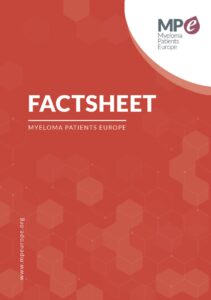What is amyloidosis?
Amyloidosis refers to a group of diseases characterised by the accumulation of an abnormal protein called amyloid which builds up in tissues and organs. Amyloidosis is a serious condition which can lead to life-threatening organ failures. It is considered a rare disease due to its low incidence.
There are several types of amyloid diseases. AL amyloidosis (also called light chain amyloidosis) is the most prevalent type, which accounts for more than three-quarters of amyloidosis cases, with an estimated incidence of 9 cases per million inhabitants/year. However, it is thought that misdiagnosis due to the clinical scenarios that mimic this condition may mean the true figure is higher.
What is the relation between AL amyloidosis and myeloma?
AL amyloidosis is related to myeloma in two ways. Firstly, as in myeloma, abnormal plasma cells in the bone marrow are source of the pathology. Plasma cells are part of the immune system that, under normal conditions, make antibodies to fight infections. Plasma cells make a certain type of proteins called immunoglobulins, which act as antibodies. They are composed of four protein chains, two light chains (called kappa and lambda) and two heavy chains. In AL amyloidosis patients, plasma cells produce an abnormal immunoglobulin light chain which is deposited in tissues and organs as amyloid, causing damage and affecting organ function. Both diseases are related also in the sense that amyloidosis treatment uses the same procedures and drugs as myeloma treatment due to the similarity in their pathophysiology and the need to abolish the malignant plasma cell clone.
Approximately 12–15% of myeloma patients will develop amyloidosis, some with subclinical amyloid deposits, which means the amyloidosis is not fully manifested. In both cases this disease is called multiple myeloma associated amyloidosis and it is treated in the same way as myeloma.
How is AL amyloidosis diagnosed?
Early diagnosis of AL amyloidosis is key, as it can promote early treatment thereby preventing further organ damage. Different tests may be run to diagnose amyloidosis:
- Laboratory tests. Blood and urine tests may detect an abnormal amount of protein. Depending on the symptoms, tests may be indicated to investigate kidney, heart, thyroid or liver function.
- Imaging test. These are scans of different types which will indicate the extent of the disease. Special testing of specific organs, such as an echocardiogram and MRI (magnetic resonance imaging) for heart function, could be indicated.
- Biopsyconsists of taking a small piece of tissue from the patient. It is usually taken from the skin of the stomach area (abdominal fat biopsy) or the rectum, or occasionally the organ affected by amyloid deposits.
What are the main AL amyloidosis treatments?
The aim of the therapy is firstly to stop the organ damage and then to allow for improvement in the function of organs such as the heart or kidney. Recovery can be a slow process. At present, there are no specific drugs that can help the body to remove the amyloid deposits. Such drugs are in clinical trials and show great promise. Hence, the main treatment for amyloidosis is very similar to that for myeloma and relies on myeloma drugs. Both diseases have the same origin and several data show that these drugs have even better results in amyloidosis patients than in myeloma patients.
The options are either some form of chemotherapy or consideration of a stem cell transplant using stem cells taken from patients themselves. For amyloidosis patients who are relatively young and fit, a stem cell transplant (SCT) is a suitable option. SCT can provide long remission and very good results. However, if there is substantial organ function damage, especially heart involvement, then SCT may have unacceptably high risks. In addition, even the alternative chemo- immunotherapy may have severe toxicity even more than in myeloma patients.
For other patients, the alternative treatment option is chemotherapy and immunotherapy. The most important drugs for these patients are proteasome inhibitors (usually a drug called bortezomib, and more recently, newer variants of this called carfilzomib and ixazomib) that have shown outstandingly high efficacy in amyloidosis treatment. These drugs have essentially changed the landscape of this disease. They are used in combination with other agents and provide deep durable responses.
In addition to proteasome inhibitors, the current physician’s choice of treatment consists of chemotherapy drugs such as melphalan, cyclophosphamide and immunomodulators (such as thalidomide, lenalidomide and pomalidomide). Recently, daratumumab, an anti-CD38 antibody very effective in myeloma, was shown to be extremely effective in amyloidosis patients, with both durable responses alone or combined with bortezomib based treatments, and subsequently good organ responses regaining function.
References
- Orphanet Journal of Rare Diseases – AL Amyloidosis, E.Desport et al. – 21 August 2012 -https://ojrd.biomedcentral.com/articles/10.1186/1750-1172-7-54
- Medscape – Pitfalls in the Diagnosis of Primary Amyloidosis – Cheng E. et al. – Clin Lymphoma Myeloma. 2010;10(3):177-180. – http://www.medscape.com/viewarticle/723576
- What is new in diagnosis and management of light chain amyloidosis? – Giovanni Palladini, Giampaolo Merlini. https://doi.org/10.1182/blood-2016-01-629790
- Bahlis, N., Lazarus, H. Multiple myeloma-associated AL amyloidosis: is a distinctive therapeutic approach warranted?. Bone Marrow Transplant 38, 7–15 (2006). https://doi.org/10.1038/sj.bmt.1705395
